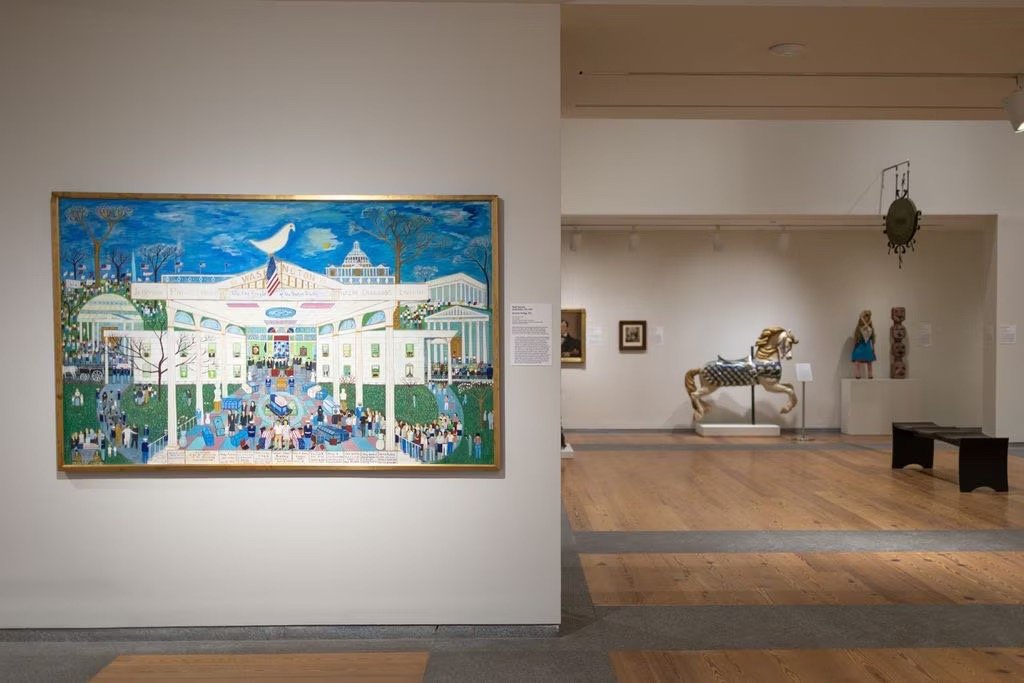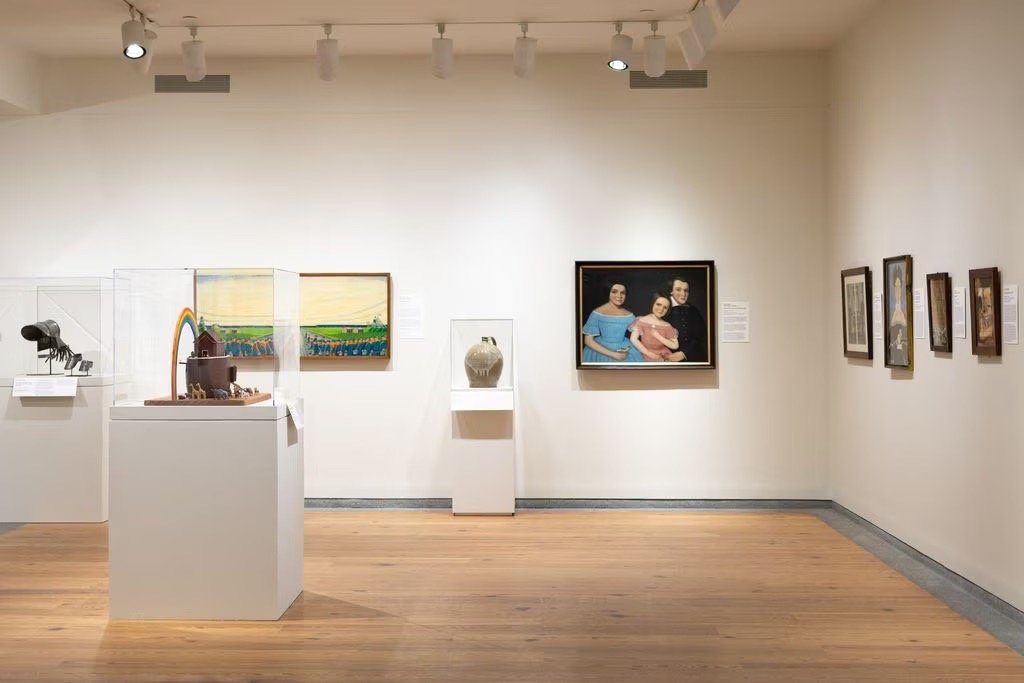Boston Globe: 'American Perspectives' at the Portland Museum of Art begs the question: What is folk art?
By Murray Whyte
April 13, 2023
An installation view of the exhibition "American Perspectives" at the Portland Museum of Art. In the foreground is the painting "American Heritage," 1974, by Robert Fasanella. PORTLAND MUSEUM OF ART, MAINE
This article originally appears in the Boston Globe.
PORTLAND — “American Perspectives” is the anodyne title of a traveling exhibition from New York’s American Folk Art Museum, now on a stop at the Portland Museum of Art. It’s hard to imagine a name less declarative, the underwhelming sort of label one applies when perfectly content not to be noticed.
Folk art has always had a self-esteem problem, but that’s not its fault. Until very recently, the genre — described, ungenerously, as things made by those uneducated, untrained, and thereby unacceptable to the established art world — was either kept hived off from proper museum collections; or, in the case of places like the AFAM, sequestered in another building entirely, the better to protect the movements and -isms of the real art world from its taint.
Often, what qualifies as folk art are functional objects, like a sign, or a clock, or, in one lovely example here, a hand-carved carousel horse. For the oh-so-erudite fine art world, this, of course, would never do; art’s reason for being is to have no function other than to be. If useful objects could be art, the thinking went, then what is art at all? That’s a question no one particularly wanted to answer, and the doors stayed locked.
As recently as a decade ago, I’d be willing to bet, “American Perspectives” would have had a hard time finding an obscure corner of a museum like the PMA, let alone its feature exhibition space, what with Degas and Monet shimmering gloriously nearby. Now, it’s a hot ticket, with eight stops on this tour.
I hesitate to use a word like “legitimize” because that implies it was not. But given folk art’s historical malignment, I think it fits. As with any incremental journey, there are signposts. The core exhibition of the 2013 Venice Biennale, “The Encyclopedia Palace,” was jarringly replete with “outsider” art (folk’s more contemporary, equally derided cousin); in 2018, the National Gallery in Washington, D.C., opened “Outliers and American Vanguard Art,” a purposeful meshing of outsiders and insiders that its curator, Lynne Cooke, intended as a challenge to the barriers between them. More recently around here, the Museum of Fine Arts exhumed its folk archives for “Collecting Stories: The Invention of Folk Art” in 2021, declaring its own historical queasiness with the form as misguided classism. The institution put a fine point on that admission by hiring a dedicated curator of folk art, Michael Bramwell, about a year ago.
And so, here we are. “American Perspectives” is chock full of inviting oddities and some truly great works, spanning nearly 2½ centuries, from rural to urban, north to south, east to west. This, largely, is its problem: Folk art, as a kitchen-sink category, is starting to feel obsolete; the art world is well into a chapter where broader, more inclusive histories are the norm, not the exception. The show made me wonder if the idea of a folk art museum itself was outmoded let alone an exhibition under that rubric.; it felt anachronistic, a ghettoization that scholars and curators are making strides to leave behind.
An installation view of “American Perspectives” at the Portland Museum of Art. PORTLAND MUSEUM OF ART
That day will come. For now there are gems to be found amid “American Perspectives’s” broad gamut.
Folk art, with its fundamental qualifier being lack of formal training, inevitably becomes a catch-all for anything the art world marks as “other.” This will leave you gawking at clumsy portraiture, like Sheldon Peck’s 1840 paintings of Increase Child Bosworth and his wife, Abigail Munro Bosworth Simonds, flat and blank-eyed, around whom he’s painted crude, faux wood frames; and enthralled by the mastery of David Drake, a posthumous art world superstar whose outsize ceramic jars stand as totems of both artistic achievement and the grotesque conditions of industrial slavery under which they were made. The two should hardly occupy the same universe, let alone the same room (you can see Drake in full and proper context at the MFA’s “Hear Me Now,” until July 9).
To be clear: I love many, many things here. There are lovely examples of historic commercial art — a terrific 1832 sign for a coffeehouse, with its counter and shelves rendered in perspective as flat as the Manitoba plains. But too many artists here deserve better than to be lumped alongside such curiosities. Ralph Fasanella, whose huge, chock-full paintings address American traumas like the civil rights movement (“American Heritage,” 1974) and class discrimination (“Workers’ Holiday — Coney Island,” 1965), explores critical elements of the American identity; his work has a powerful perspective.
The show name-checks artists who have long since transcended simplistic folk labels: Henry Darger, the Chicago custodian who spent his off-hours creating fantasy worlds in text and image starring his crusading anti-child-slavery heroes, the Vivian Girls; and Nellie Mae Rowe, who transformed her Atlanta-area home and garden into a dream-state refuge from the everyday nightmare of discrimination in the South. (Rowe’s the subject of a new documentary that’s well worth your time). They, and others here, created worlds far more expansive and complex than the folk label implies; why they share an exhibition with a wooden carousel horse is a question worth asking.
At center: "Mother Sister May Have Sat in That Chair When She Lived in This House Before Me," Jean-Marcel St. Jacques, 2014, is part of "American Perspectives," at the Portland Museum of Art.PORTLAND MUSEUM OF ART
Three-quarters of the way through the show, enough was enough. A 7-by-8-foot bricolage of wooden fragments lacquered in bright and gritty hues loomed over me, a magnum opus of found objects and creative reuse. Its title stopped my heart: “Mother Sister May Have Sat in That Chair When She Lived in This House Before Me,” a 2014 piece by the artist Jean-Marcel St. Jacques.
Cobbled from the wreckage of Hurricane Katrina near his home in the Tremé district of New Orleans, St. Jacques’s piece achieves a formal and conceptual union that only the best art can aspire to. Its details unravel an enormity of loss measured in tiny increments. Its entirety embodies the futile enterprise of reconstruction, and how fragments, however reassembled, can never truly become whole.
If it were made, say, by Theaster Gates, a bona fide star who often works with materials and themes like this, it would be coveted by contemporary collections across the country. St. Jacques’s lack of a master’s degree (Gates has one) is an absurd disqualifier for a piece that has every right to be totemic in American contemporary art.
It tells you something, I think: As far as we’ve come, there’s still far to go. And shows like “American Perspectives,” with their jarring disconnects, will help get us there, if by frustration alone.
AMERICAN PERSPECTIVES: STORIES FROM THE AMERICAN FOLK ART MUSEUM COLLECTION
Through May 7. Portland Museum of Art, 7 Congress Square, Portland, Maine. 207-775-6148; portlandmuseum.org



